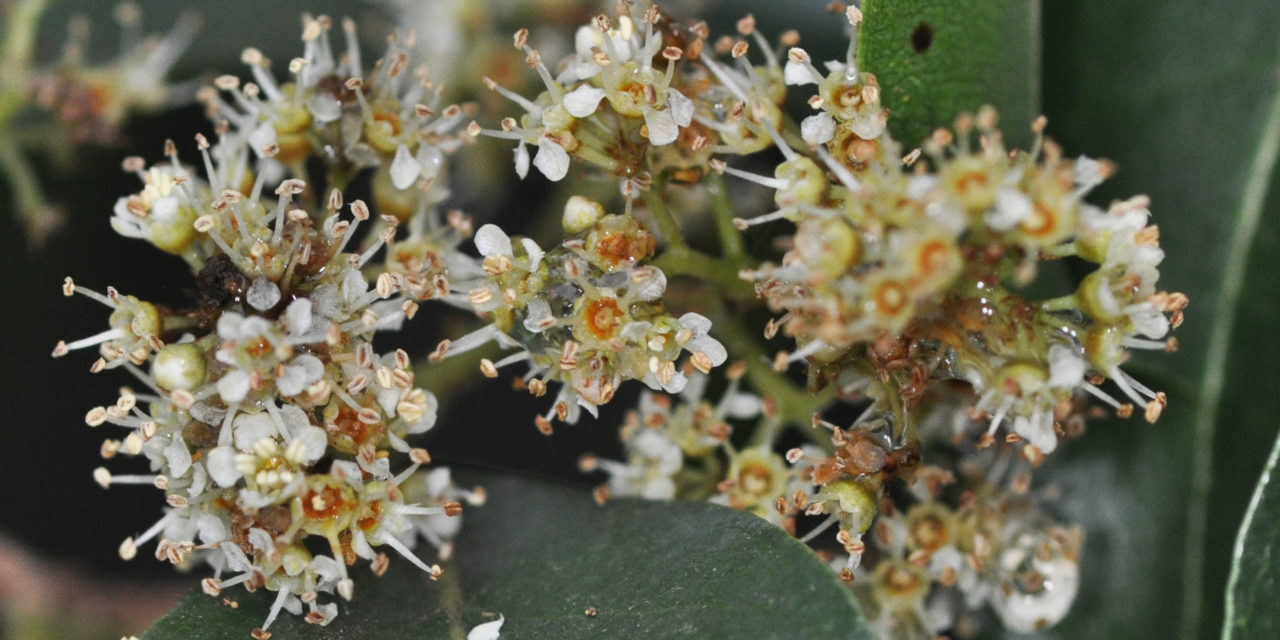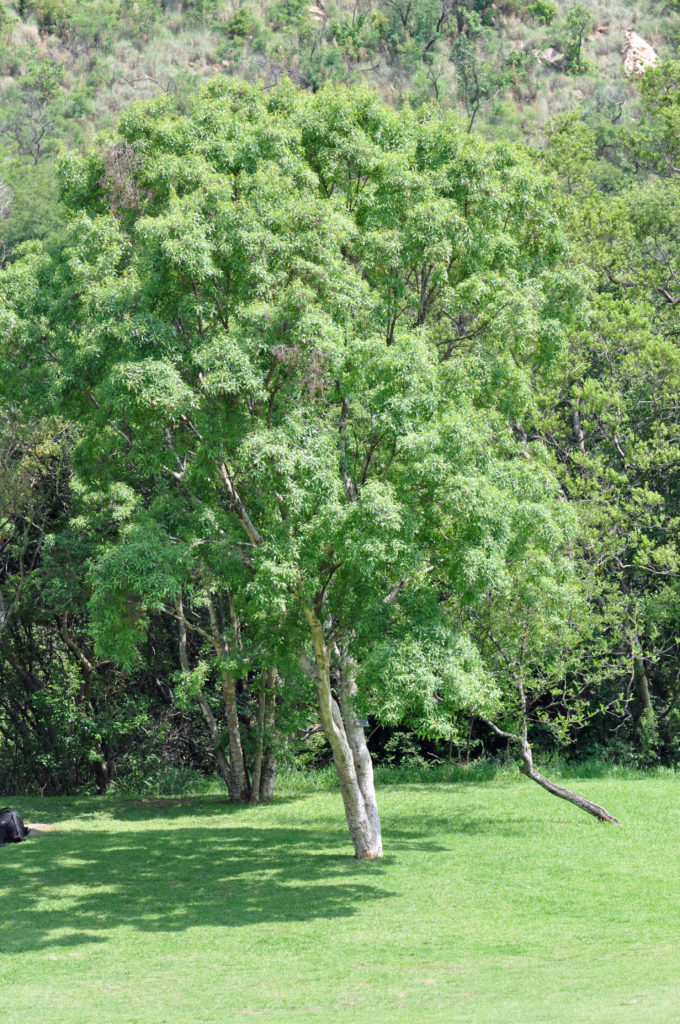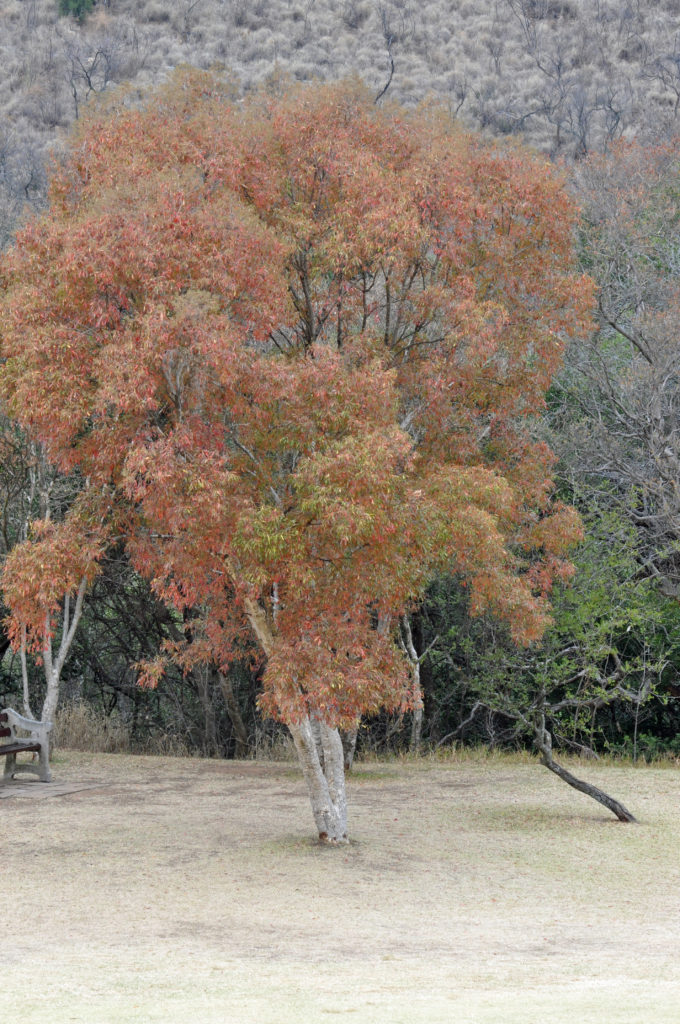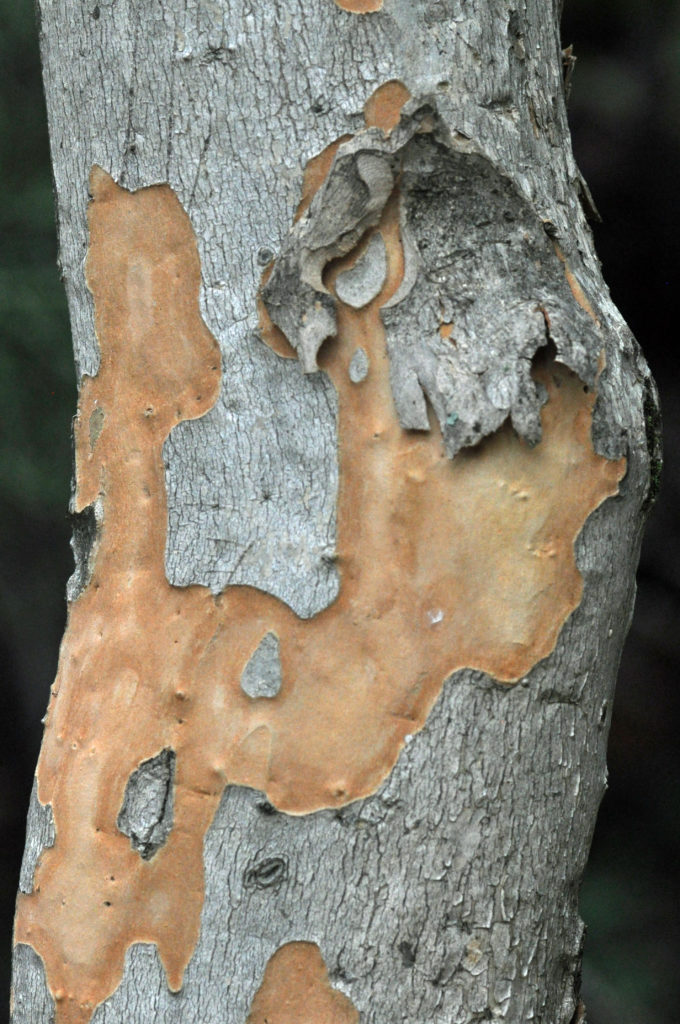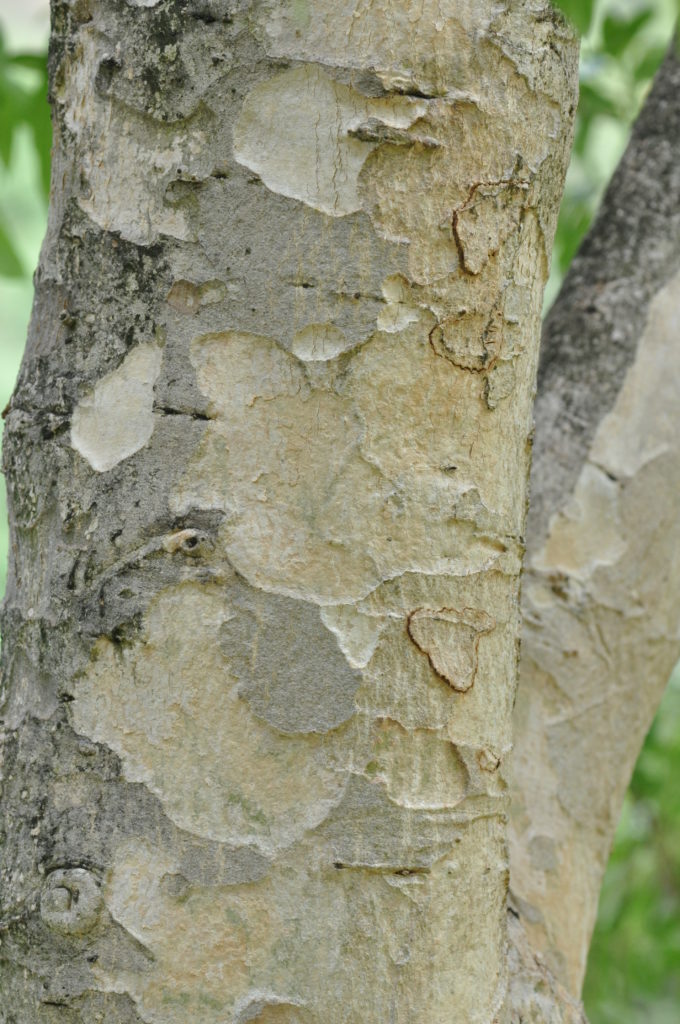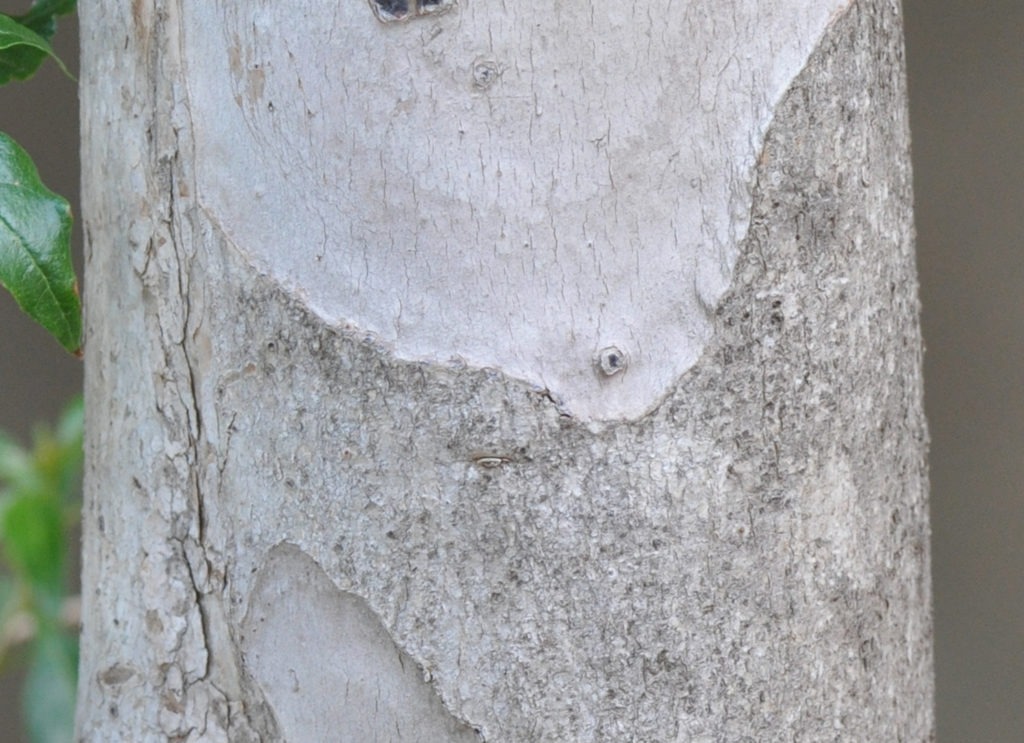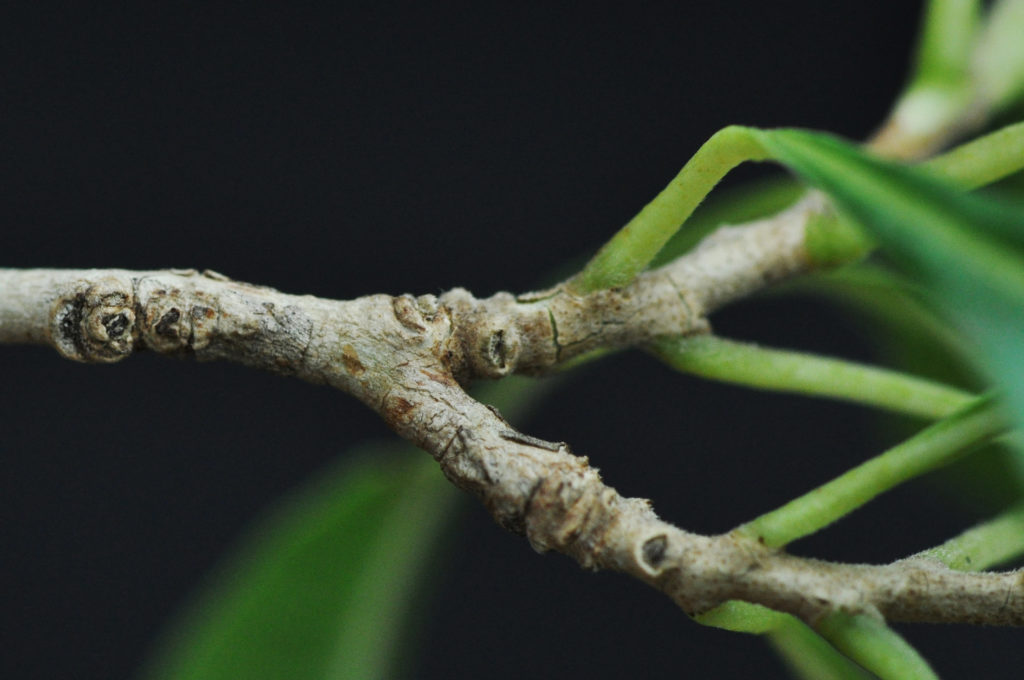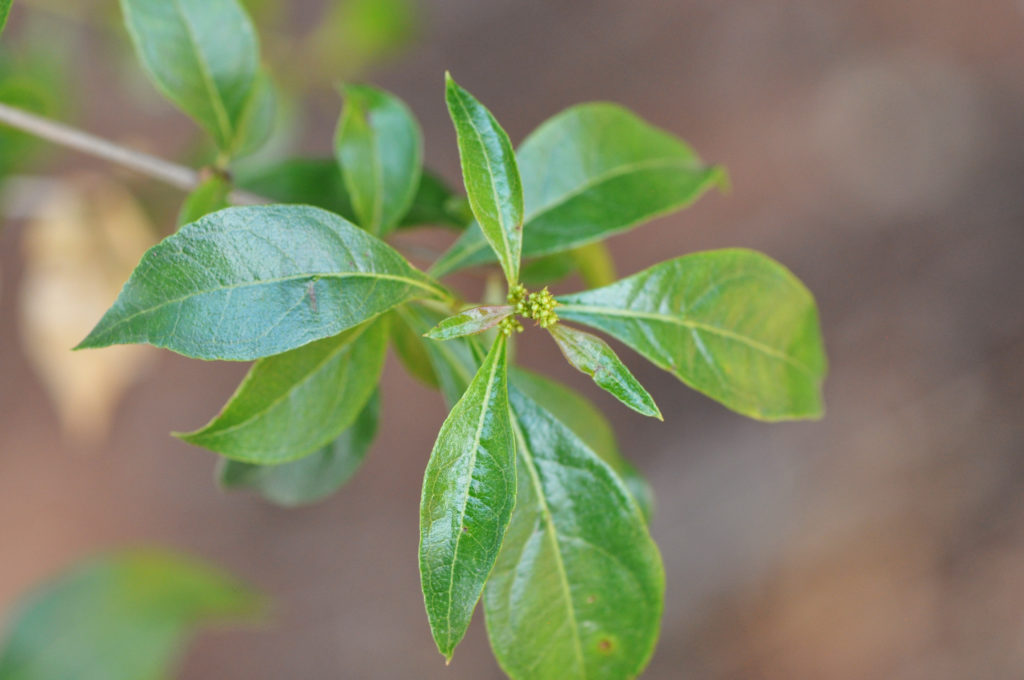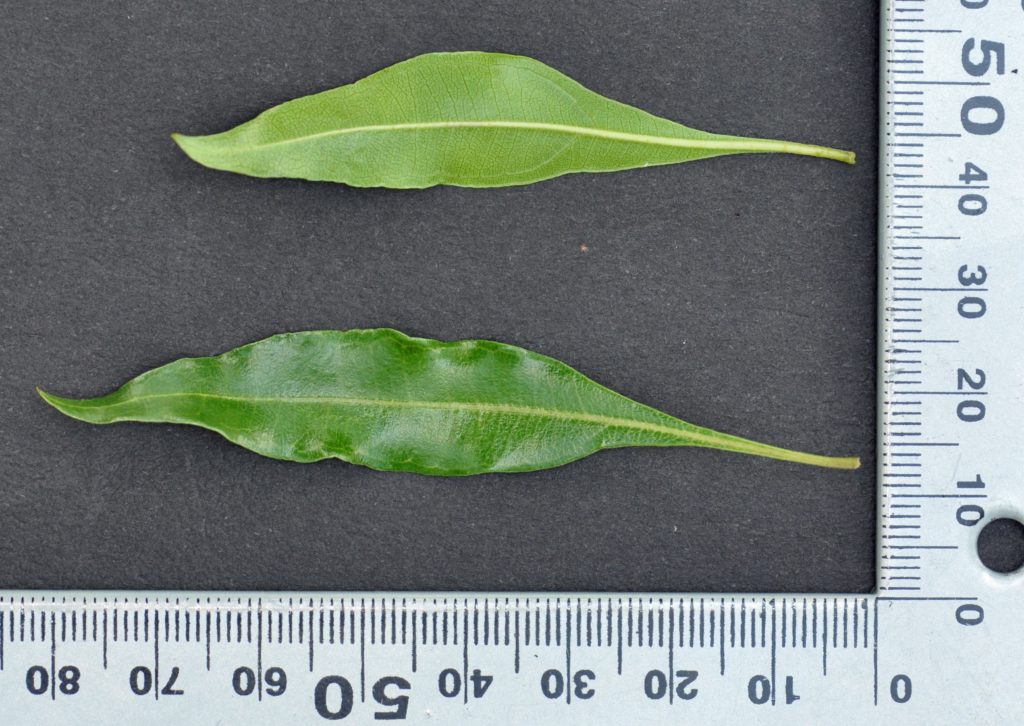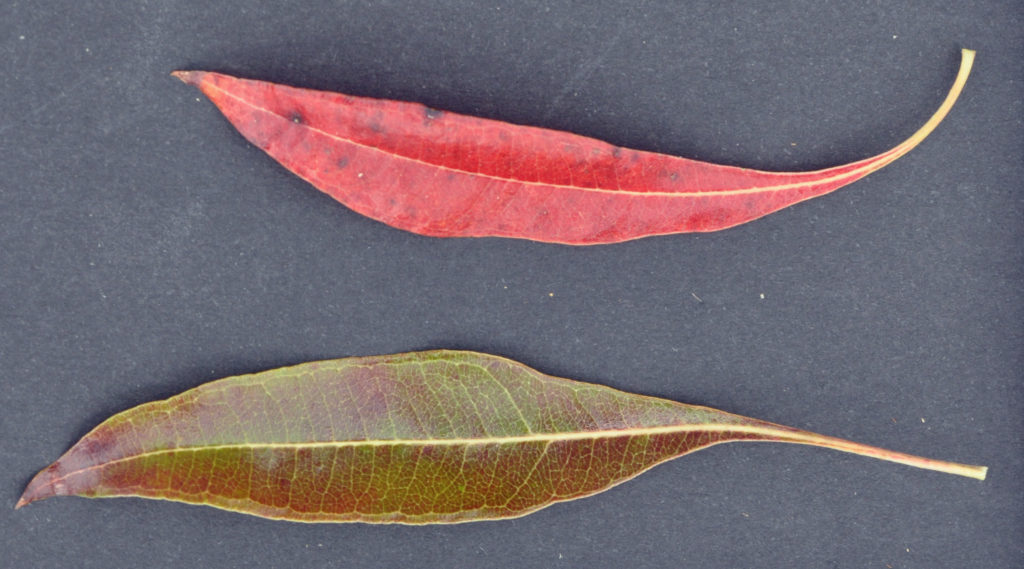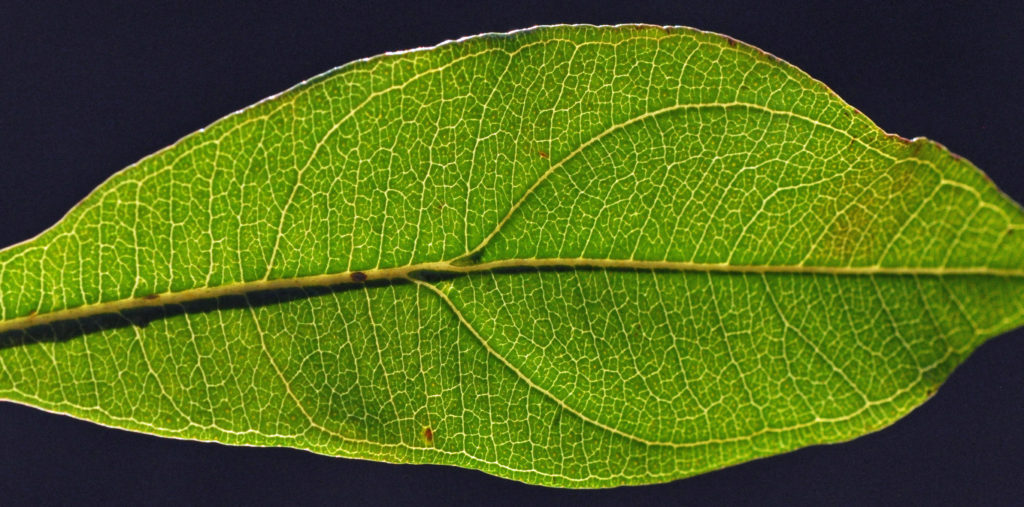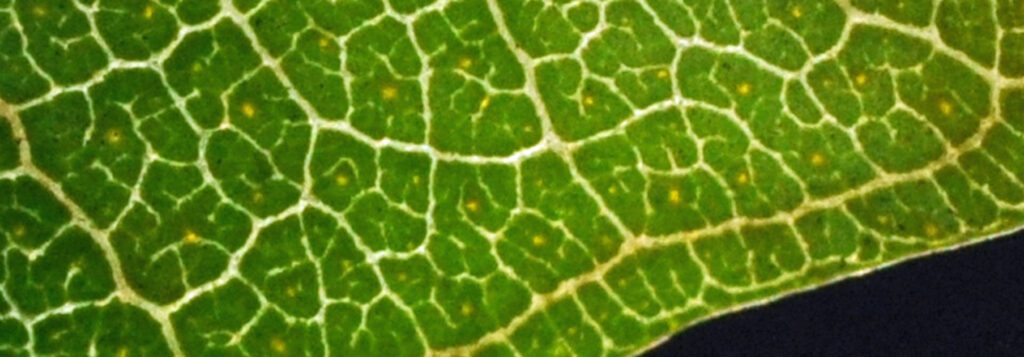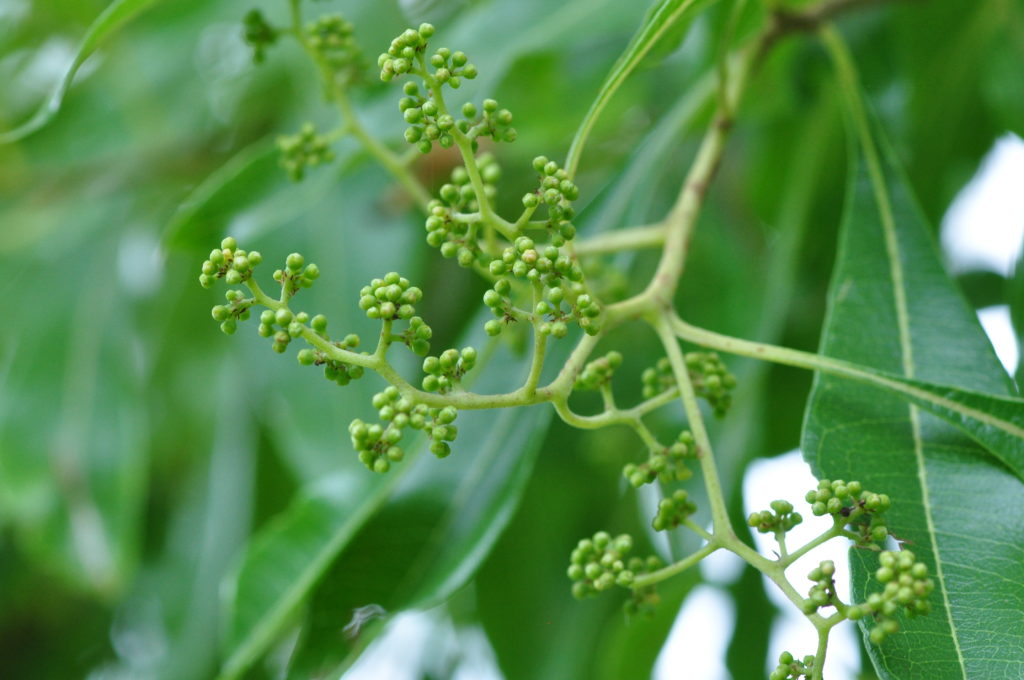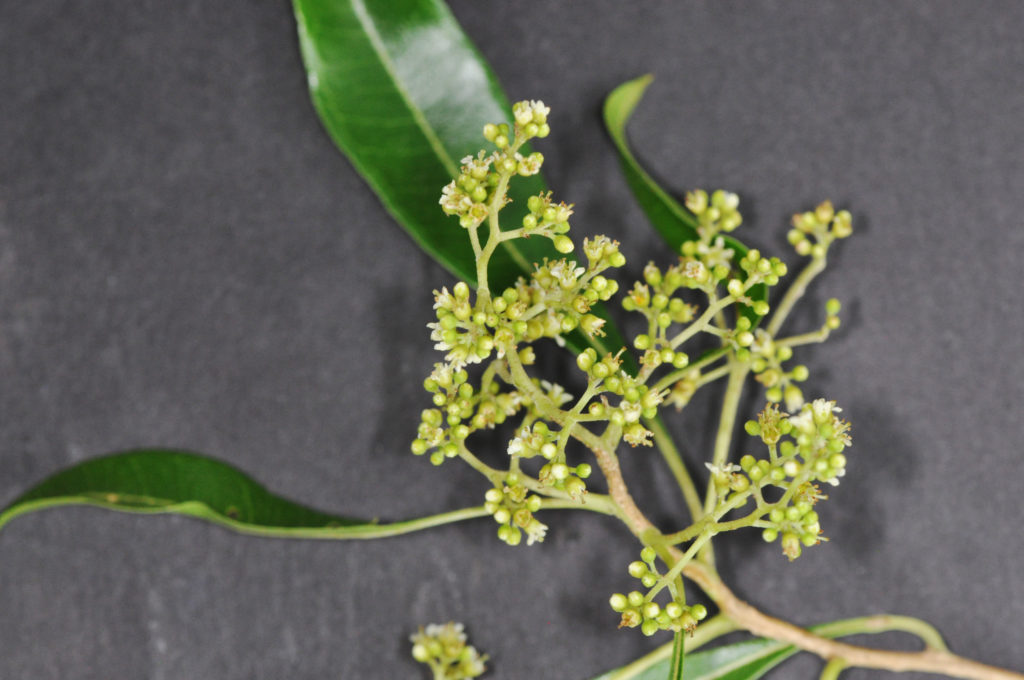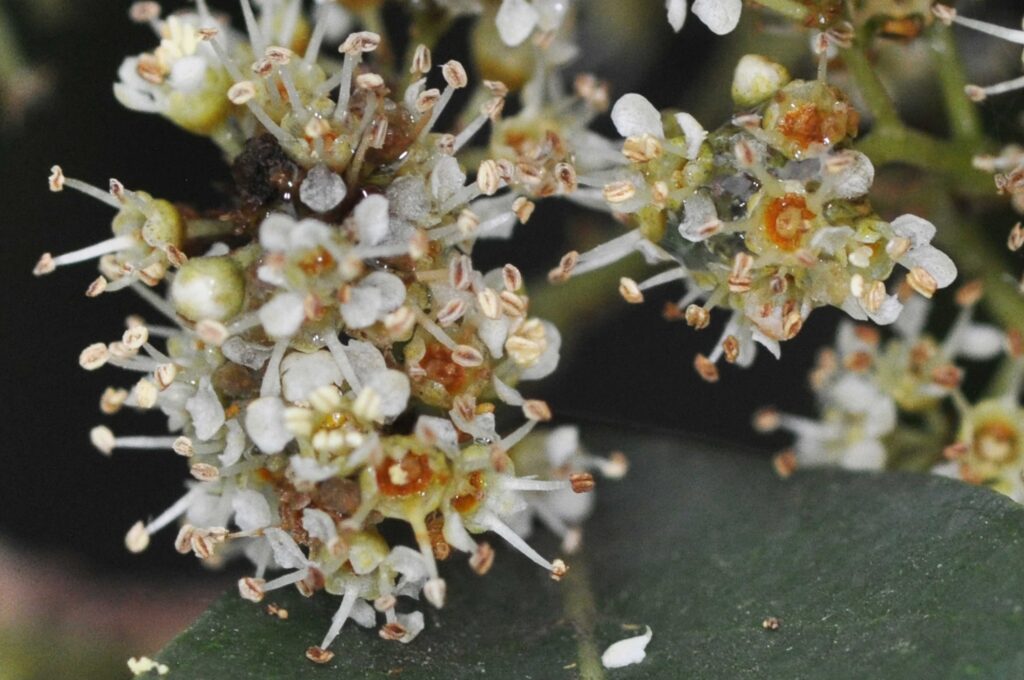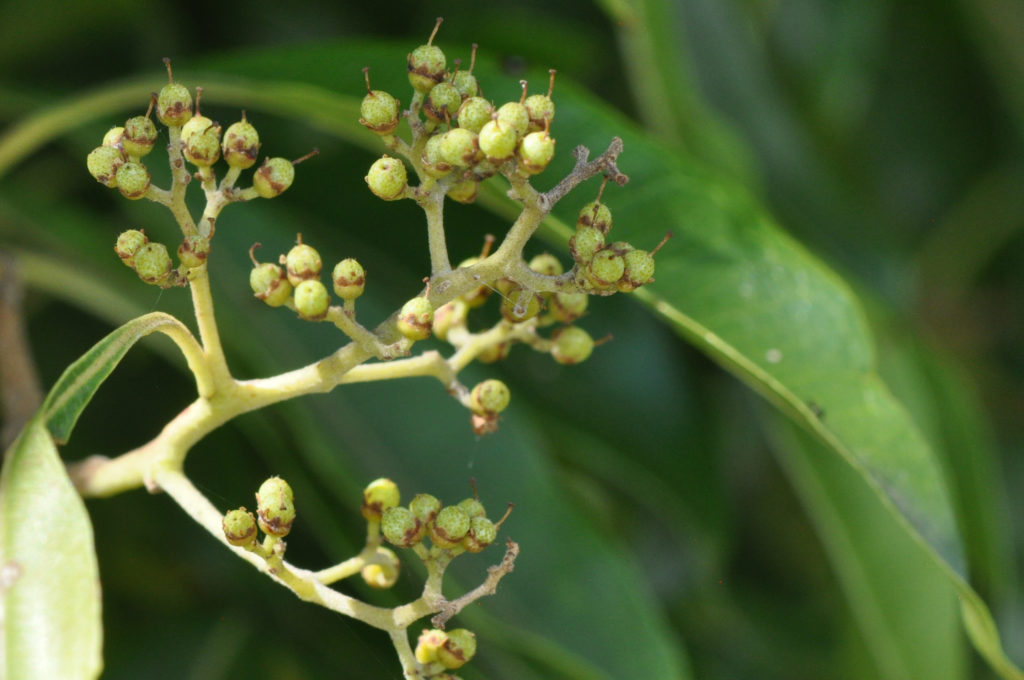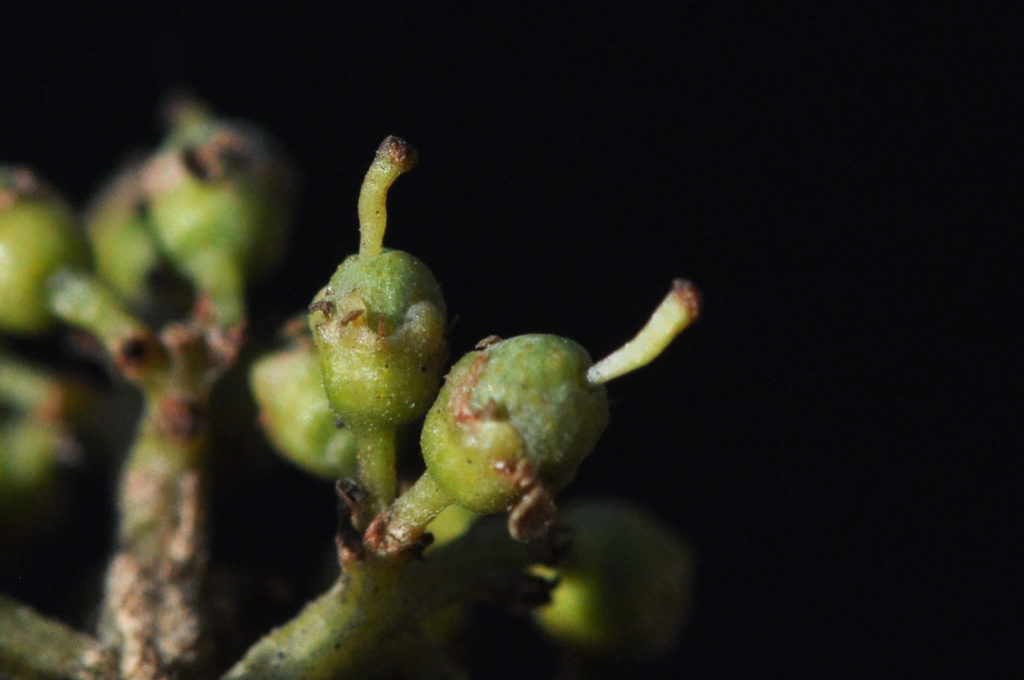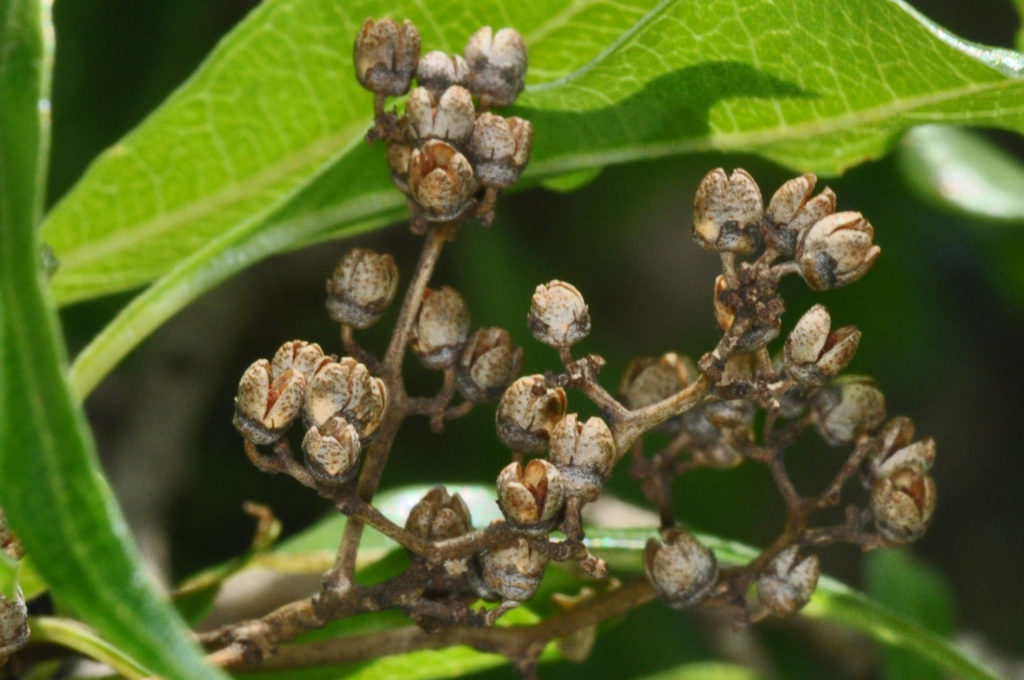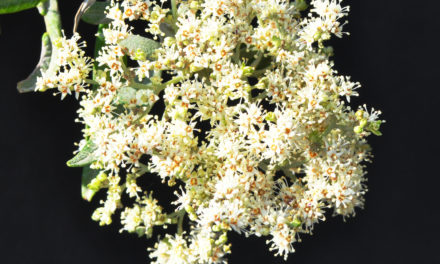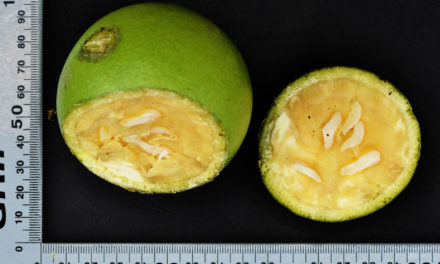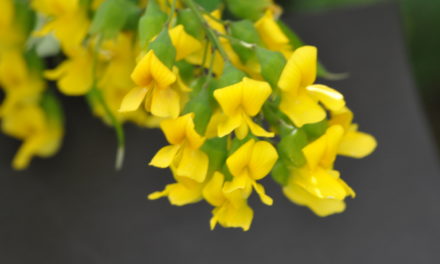General Info – summary
This weather dependent deciduous Tree lacks thorns & is usually up to 10m high. It has flaking mottled bark. Simple Leaves have entire margins & smell of lavender when crushed. Small unisexual 5-merous Flowers have extended stamens and the superior ovary has a style with a capitate stigma. Fruit: a small glossy capsule protruding beyond the persistent calyx. Tiny, winged, 3-angled seeds are wind dispersed.
Description
Heteropyxis natalensis
SA Tree No. 455.
Common names: (Afr) Laventelboom, Leventelboom, Wildelavental. (Eng) Lavender-tree, Wild Lavender. (isiZulu) Inkunzi, Inkuzwa, Umkhuswa, Umkhuze. (siSwati) Incuze, Inkunzane, Inkunzi, Inknzi, Uhuzu, Umhlosheni. (Tshivenda) Mudedede, Munukha-vhaloi, Vhaloi. (Xitsonga) Thatasane.
Family: Myrtaceae (Heteropyxidaceae). (Myrtle and Eucalyptus family) has 130+ genera and 3 000+ species and includes the Australian genus Eucalyptus, as well as guava and clove. These mostly evergreen trees have simple Leaves that are leathery, usually entire, gland-dotted and usually opposite. Stipules are very small or absent. Flowers are regular usually bisexual and 4 or 5-merous. However, petals may be small or absent. The many Stamens are inflexed in the bud and Anthers are 2-thecous (with 2 pollen sacs). They usually open by lengthwise slits. The usually inferior Ovary has a simple Style with a capitate Stigma. The Fruit is a capsule or berry with a persistent Calyx. Local genera with trees on this website include Eugenia, Heteropyxis, Metrosideros (Western Cape) and Syzygium.
Name derivation: Heteropyxis – distinct or different with a box like lid – referring to the capsule. natalensis – from KwaZulu-Natal. The other 2 local species are Heteropyxis canescens, and H. dehniae.
Conservation: National Status: L C. (Least Concern). Assessed: 2005 (W. Foden and L. Potter).
Tree
The height of this Tree with its rounded crown (photo 247) is usually up to 10m but may reach 15m in ideal conditions e.g. in Zimbabwe. It can also be a shrub. From a distance, the slender Trunk may appear white, grey or even orange and may have more than one stem (photo 822). It is slender and can be crooked or even grooved. The Bark may be smooth or have a distinctive mottled appearance. Like Heteropyxis canescens, fairly large pieces may flake off from older stems revealing an orange under-bark (photo 725), which soon fades (photos 836 & 385). The bark eventually becomes white or grey. Leaf scars are visible on youngish stems (photo 287). Twigs (1-year-old current branch segments) are hairless. No thorns are present on this plant.
- 247. 2014/12/02. Walter Sisulu NBG. Photo: David Becking.
- 822. 2015/08/11. Walter Sisulu NBG. Photo: David Becking.
- 725. 2017/01/31. Pretoria NBG. Photo: David Becking.
- 836. 2015/11/17. Walter Sisulu NBG. Photo: David Becking.
- 385. 2014/02/20. Marakele NP. Photo: David Becking.
- 287. 2018/01/11. Walter Sisulu NBG. Photo: David Becking.
Leaves
On this weather dependent deciduous tree, the smooth, often drooping Leaves (photo 386) are simple (have a single blade which may have incisions that are not deep enough to divide the leaf into leaflets). The tree is deciduous in cold areas and may develops rich red, brown and yellow autumn colours (photo 827 and photo 822 above). Young leaves are bright green (photo 583) and may be tinged with red. The arranged of leaves around branchlets is usual alternative but may be spiral. Leaves are narrowly to broadly lanceolate or narrowly elliptic and usually up to 9 x 2,5cm. In slightly rugose (wrinkled surface photo 238), leathery mature leaves, the Upper surface is (glossy green and is slightly darker than below (photo 238). Here the Midrib (the main rib of a leaf or leaf-like part, a continuation of, but excluding the petiole). On the Lower surface, only the clearly defined protruding Midrib is visible (photo 238). The leaves tend to fold slightly along the midrib (photo 827). All veins are best viewed against a strong light (photo 340). Here a hand lens will help. There is often a pair of prominent side veins that initially move towards the margin before bending and ending close to the apex (photo 340). The smooth blade has gland dots which can be seen against a strong light with the aid of a hand lens (photo 628). These glands are responsible for the pleasant smell of lavender, released in crushed leaves. The scent persists – even in dried leaves. The Apex tapers to a narrow point (photo 386) and may form a drip-tip. It may be acuminate (said of an acute apex whose sides are somewhat concave and taper to a protracted point) to attenuate (showing a long gradual taper of base or apex). The Base tapers narrowly and may be reddish. The slightly wavy Margins are entire (with a continuous margin, not in any way indented) and are not rolled under. The Petiole (leaf stalk) is up to 2,4cm long (photo 827). It may be pinkish and is grooved above. Stipules (basal appendages of the petiole) are rudimentary or absent. Leaves are hairy and reddish only when young – apart from occasional hair-tuft Domatia (a tiny chamber produced by plants that house arthropods that develop in vein axils). To the naked eye, the domatia appear as small bumps.
- 386. 2014/02/20. Marakele NP. Photo: David Becking.
- 238. 2014/12/02. Walter Sisulu NBG. Photo: David Becking.
- 827. 2015/08/11. Walter Sisulu NBG. Photo: David Becking.
- 340. 2018/10/05. Pretoria NBG. Photo: David Becking.
- 628 2018.05.29 Pretoria NBG. Photo: David Becking.
Flowers
Tiny greenish-white buds develop into small, whitish or creamy yellow, sweetly fragrant Flowers – each about 3mm wide. Flowers occur in spreading axillary and terminal Panicles (indeterminate, branched inflorescence with stalked flowers – photos 229 & 326). Flowers are actinomorphic (Regular, symmetrical. Flowers are vertically divisible into similar halves by more than 1 plane passing through the axis). The Pedicels (flower stalks) are hairy. Flowers are perigynous (having sepals, petals, and stamens around the edge of a cuplike receptacle containing the ovary). The gland dotted Calyx is cup-shaped with 5 overlapping Sepals. The Corolla has 5 free, imbricate (having regularly arranged, overlapping edges, as roof tiles) and early falling White Petals (photo 635) that alternate with the sepals and arise from the inner rim of the hypanthium (the cup-like receptacle derived usually from the fusion of floral envelopes and androecium, and on which are seemly borne calyx, corolla and stamen). Once the white petals fall, the remains are yellowish. The Disc (a more or less fleshy or elevated development of the receptacle or of coalesced nectaries or staminodes about the pistil) is well developed. The Anthers usually have 5-7 initially folded Filaments, which straighten and extend the Anthers (with 2 thecae – pollen sacks) well above the corolla (photo 635). The Pistil (a unit of the Gynoecium, the female element of the flower, composed of the Ovary, Style and Stigma) has an almost spherical superior Ovary and is usually 2-3 locular (compartment within an organ) with numerous Ovules. The Style is short but slightly persistent (see photo 627 under Fruit). In this photo, the slightly capitate (formed like a head) Stigma is visible. (Dec – Mar).
- 229. 2014/02/04. Walter Sisulu NBG. Photo: David Becking.
- 326. 2015/02/24. Walter Sisulu NBG. Photo: David Becking.
- 635. 2017/01/31. Pretoria NBG. Photo: David Becking.
Fruit
The tiny, spherical or broadly ellipsoidal, glossy and gland dotted Fruit is a Capsule (a dry fruit resulting from the maturing of a compound ovary, which usually opens at maturity by one or more lines of dehiscence), which is up to 3 x 2mm. Fruit occurs in dense clusters, with more than half its length protruding beyond the persistence Calyx (photo 627). The Style is still visible in the early stages of fruit formation (photos 723 & 627). The capsule remains on the tree and finally splits from the apex – releasing the tiny, dark brown, 3-angled Seeds. The slightly winged seeds are wind dispersed. Old capsules remain on the tree for months (photo 244). (Mar-Jul).
- 723. 2015/04/21. Walter Sisulu NBG. Photo: David Becking.
- 627. 2018/05/29. Pretoria NBG. Photo: David Becking.
- 244. 2014/12/02. Walter Sisulu NBG. Photo: David Becking.
Distribution & Ecology
These Trees are endemic in southern Africa. (Endemism is the ecological state of a species being unique to a defined geographic location). They occur in KwaZulu-Natal, Mpumalanga, Gauteng and Limpopo as well as Swaziland, mainly southern Mozambique and Zimbabwe. This tree Grows in the bushveld (a sub-tropical woodland ecoregion of southern Africa), riverine bush and rocky slopes in mixed deciduous woodland, and from close to sea level to 2 000m. Leaves attract bees, moths and butterflies. Black Rhino, Grey-duiker and Kudu browse the Leaves. Rhino also eat the Bark. Flowers attract butterflies, bees and wasps.
Ethnobotany
The Wood is a brownish purple, fine grained, hard and tough. It is used for fence posts and charcoal. It is a good garden tree and used in bonsai. Herbal tea and perfume can be made from the Leaves. The leaves are used to scent tobacco and for potpourri (a mixture of dried petals and spices placed in a bowl to perfume a room). Trees can be Grown from seeds or cuttings and are fast growing – up to 1m per year. The tree is frost sensitive when young. Plant the tree in full sun. They are good for bonsai. Local medicine makes use of roots, leaves, twigs and bark.
References
Boon, R. 2010. Pooley’s Trees of eastern South Africa. Flora and Fauna Publications Trust, Durban.
Burrows, J.E., Burrows, S.M., Lotter, M.C. & Schmidt, E. 2018. Trees and Shrubs Mozambique. Publishing Print Matters (Pty) Ltd. Noordhoek, Cape Town.
Coates Palgrave, M. 2002. Keith Coates Palgrave Trees of Southern Africa, edn 3. Struik, Cape Town.
Foden, W. & Potter, L. 2005. Heteropyxis natalensis Harv. National Assessment: Red List of South African Plants version 2020.1. Accessed on 2023/07/19.
Lawrence, G. H. M, 1951. Taxonomy of Vascular Plants. The Macmillan Company, New York. Tenth Printing 1965.
Palmer, E. & Pitman, N. 1972. Trees of southern Africa. Balkema, Amsterdam, Cape Town.
Schmidt, S. Lotter, M. & McCleland, W. 2002. Trees and Shrubs of Mpumalanga and the Kruger National Park. Jacana, Johannesburg.
van Wyk, B. & van Wyk, P. 1997 Field guide to Trees of Southern Africa. Struik, Cape Town.
file:///C:/Users/Probook/Downloads/382-1452-1-PB.pdf
http://plantzafrica.com/planthij/heteropnatal.htm
http://witkoppenwildflower.co.za/heteropyxis-natalensis/
http://www.operationwildflower.org.za/index.php/albums/trees/heteropyxis-natalensis-jw-1610
https://en.wikipedia.org/wiki/Heteropyxis
http://posa.sanbi.org/flora/browse.php?src=SP
http://www.ipni.org and http://apps.kew.org/wcsp/

